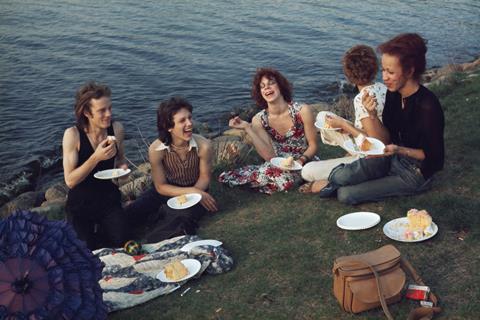
Laura Poitras, the Oscar and Golden Lion-winning director of documentaries including Risk, Citizenfour and this year’s All The Beauty And The Bloodshed, revealed the calculated risks she takes and the extraordinary lengths to which she goes to protect her footage at a masterclass at the International Documentary Film Festival Amsterdam (IDFA) this weekend where she is this year’s guest of honour.
She used the masterclass to voice her fears about what she believes will be an increased threat to filmmakers and journalists from governments if Wikileaks founder Julian Assange is extradited to the US.
“It’s important right now to emphasise the danger to journalism because of the US efforts to extradite [Assange] and prosecute him through the Espionage Act,” said Poitras. “Which is for his journalism, for publishing truthful information about US occupations and war crimes.”
Assange is currently in Belmarsh Prison in the UK as the extradition process grinds on.
He is the subject of Poitras’ 2016 film Risk. She had started filming Assange in 2011, before she went on to make her Academy Award- winning documentary, Citizenfour in 2014, featuring Edward Snowden, the whistle-blower who worked at the US’ National Security Agency (NSA) before revealing the extent of the NSA’s global mass surveillance programme.
“[Assange’s extradition order] s the biggest threat to press freedom right now,” Poitras told a packed crowd inside Amsterdam’s Carré Theatre. “It is also very personal. Everything, if you read his indictment, are things that I could be accused of.”
Of Snowden she said: “We didn’t expect to meet somebody who was 29, in a t-shirt,” recalling th moment she and her collaborator Glenn Greenwald first met the youthful Snowden in a hotel room in Hong Kong. Before this encounter, which “came with a lot of risk,” she had no idea of Snowden’s name, age or even what his job was. He was an anonymous source about the US government’s global mass surveillance programme.
“At the beginning, I thought he would want to remain anonymous and that my job would be to protect his anonymity. But at some point he said ‘my fingerprints are not going to be on it and so that’s not your job any more. Your job is to report and get the story out,’.”
Poitras described the meeting with Snowden as “scary” and “like walking into some sort of abyss.”
“In retrospect, his youth was wonderful because people then related that to why would someone so young risk so much,” the director said of him.
Poitras used her encryption skills to protect the footage from that interview. “When I was in Hong Kong, every day, at the end of the day, I was copying things to a cryptic drive, physically destroying SD cards, flushing them down a toilet and then going to a lawyer and depositing footage. I figured that if they raid us, I won’t lose everything.
Reflecting on the Citizenfour filmmaking experience, the director said “There were some really scary days and I think I was in a state of shock.” Snowden, by contrast, “was so calm…he had made peace with this decision.”
The US filmmaker was herself put on a US government “terrorist watchlist” after making her 2006 documentary, My Country, My Country, which she filmed in Iraq after the US invasion of the country.
“The US government decided I was a threat to national security. They based it, I think, on the fact that I was seen with a camera in the Red Zone,” Poitras remembered how the US authorities reacted to her shooting her film outside the so called Green Zone [the centre of the US presence in Baghdad].
“I talk about it a lot,” Poitras said about being considered as threat to national security. “I’m really proud of it. [The authorities] are paying attention and the work is causing some discomfort, which I am proud of.”
All The Beauty And The Bloodshed

Poitras spoke of her admiration for artist and activist Nan Goldin, the protagonist of All The Beauty And The Bloodshed. The film looks at Goldin’s turbulent family life while telling the story of her tireless battle to bring down the hugely wealthy Sackler family whom she held accountable for the opioid crisis in the US. Poitras spoke of Goldin’s “public- facing bravery” and the “emotional vulnerability” she brings to a film she describes as “both deeply political and deeply personal.”
On a lighter note, Poitras began her masterclass by talking about her career before filmmaking…as a chef.
“It’s not unlike film. It’s an apprenticeship process. You learn as you go.”
Poitras worked mainly in kitchens serving French food but with “different influences…the first chef I worked for was from Tunisia and there were a lot of influences from that.”
Top 10
At IDFA, Poitras has programmed 10 films that have a particular resonance for her. The list includes IDFA juror Pirjo Honkasalo’s The Three Rooms Of Melancholia; Steve McQueen’s Hunger; Chris Marker’s La Jetée; US Department of Energy 1949 film Crossroads, about the nuclear tests at the Bikini atoll; Forensic Architecture’s new short Shireen Abu Akleh: The Extrajudicial Killing Of A Journalist; Claude Lanzmann’s Shoah; Jafar Panahi and Mojtaba Mirtahmasb’s This Is Not A Film; Frederick Wiseman’s Titicut Follies; Forensic Architecture’s Torture In Saydnaya Prison and Talal Derki’s Return To Homs.






















No comments yet